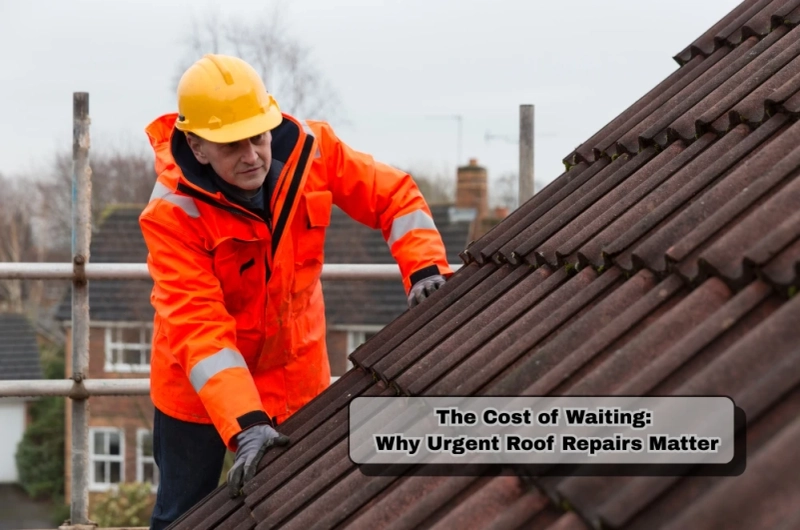If you’re staring at a water stain spreading across your ceiling or have spotted tiles scattered in the garden after last night’s storm, you know the dread that comes with roof damage. But here’s the thing: when it comes to urgent roof repairs, waiting is rarely your friend.
In my experience, the difference between “I’ll sort it next week” and “I’ll get onto it today” can be the difference between a quick patch job and a full-blown, wallet-draining disaster. Trust me—I’ve seen what happens when homeowners try to tough it out or hope a leak will disappear after a few sunny days.
So, why exactly does waiting cost so much? And what should you do when urgent roof problems appear out of nowhere? Let’s break it down, Aussie-style.
How delays can multiply your problems
Ignoring roof trouble? You’re rolling the dice. Here’s why procrastination ends up costing more:
- Leaks spread. What starts as a few drips can quickly turn into steady streams, especially after the next big storm.
- Mould takes hold. Damp roof cavities love to breed mould, which is bad news for your health and your home’s frame.
- Timber and brickwork suffer. Water seeping in over weeks or months will quietly chew away at rafters, battens, and even bricks.
- Insurance gets tricky. Most policies expect quick action. If you stall, your claim could be knocked back or delayed.
- Costs climb. What could be a $300 patch might snowball into thousands, especially if water has time to creep into insulation or wiring.
Real talk: I once watched a neighbour ignore a tiny leak, only to cop a massive bill half a year later. That little drip had crept right through the roof cavity, warped plaster, and destroyed insulation. What is the difference between fixing it early and fixing it late? About $3,000.
What happens if you let roof damage linger?
Roof damage escalates in a way that’s almost sneaky. Here’s the usual progression:
- Initial fault: Maybe it’s a slipped tile, cracked flashing, or even a stray branch after a blowy night.
- Water finds a path: With every downpour, moisture seeps a bit further—sometimes without you even noticing.
- Rot and decay: Give it a few weeks, and the timber starts to soften; metal fixings can rust, and even brickwork gets compromised.
- Mould sets in: I’ve seen mould start in less than a week, quietly spreading through insulation and down into walls.
- Damage widens: Over time, ceilings, cornices, and even nearby wiring can cop it.
- Pests move in: Wet cavities attract ants, rodents, and sometimes termites, turning one problem into several.
Last year, I ignored a musty smell in the lounge. Three weeks later, it was a full-blown stain, and the repair involved replacing Gyprock, treating mould, and cleaning insulation. If I’d acted the first day, it would’ve been a much cheaper fix.
Understanding the real risks (beyond just leaks)
When we talk about roof tiling work, it’s not just about leaks. Unattended roof damage can create safety hazards you might not think of:
- Falling tiles: Dislodged tiles can come loose, especially in high winds dangerous for anyone below.
- Electrical risks: Water tracking through a roof cavity can reach light fittings or wiring.
- Compromised insulation: Wet insulation loses its effectiveness, pushing up your power bills.
- Legal and insurance exposure: According to the NSW Government’s guidance on roof tiling work, unlicensed or delayed repairs may breach compliance obligations, especially if you’re a landlord or business owner.
What to do when urgent roof repairs are needed
If you’ve spotted a problem, don’t panic—but don’t wait, either. Here’s a quick action plan:
- Stay safe first. If water is dripping near electrical fittings, turn off the power to that room.
- Minimise interior damage. Move valuables and furniture away from leaks. Place buckets or towels to catch drips.
- Take photos. Document damage for insurance—snap the leak, stains, and any outdoor issues.
- Contact a licensed roofer. Don’t try dangerous fixes yourself—call a pro with experience in urgent roof repairs.
- Check your policy. Notify your insurer as soon as possible, especially if the weather event is widespread.
How to choose the right help for urgent repairs
Choosing the right tradie makes all the difference—especially when you’re stressed by a roof emergency. Look for:
- Current licensing and insurance.
- Local experience and good reviews.
- Clear communication about scope, timing, and cost.
- Emergency callout options.
- Warranty on repairs.
If you’re feeling overwhelmed, consider seeking further guidance on handling urgent roof issues for tips on what to ask and what to expect during the repair process.
Can you prevent future urgent roof repairs?
No one can control the weather—but you can get ahead of most roof issues with a little planning:
- Inspect after major storms. A quick look for missing tiles or flashing saves pain later.
- Scheduling regular roof checks once a year is a smart investment, especially for older homes.
- Clear gutters and downpipes. Blocked drainage is one of the top causes of leaks.
- Act early on any warning signs. Stains, drips, or new drafts = time to investigate.
I’ve learned to spot small problems early, and it’s paid off. A cracked tile caught during a routine clean cost me less than a dinner out—compared to the nightmare I had the year before when I ignored a “minor” leak.
The real cost of waiting: A quick summary
Delaying urgent roof repairs can lead to higher repair bills, health and safety risks, insurance headaches, potential legal issues, and long-term damage to your home’s value. If you notice signs you need roof leak repair, act now. You’ll save money, headaches, and maybe even a few Saturday afternoons that could be spent doing something better than cleaning up after a leak. When it comes to urgent roof issues, a quick response is always your best bet.



